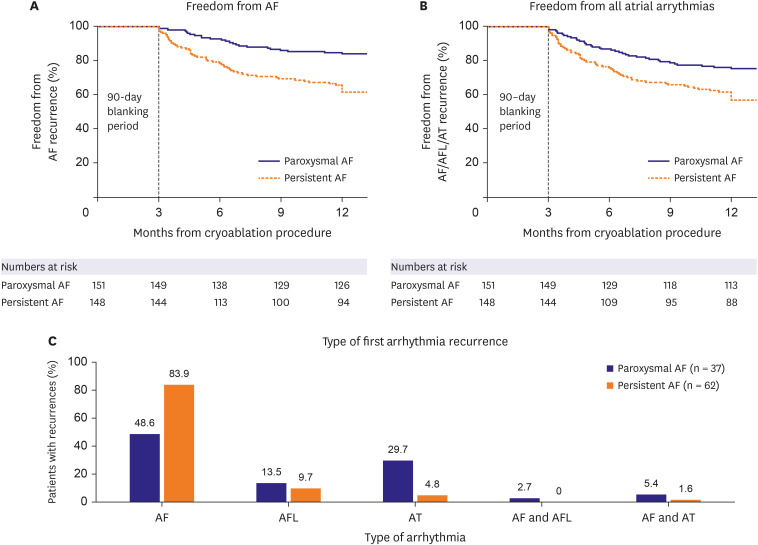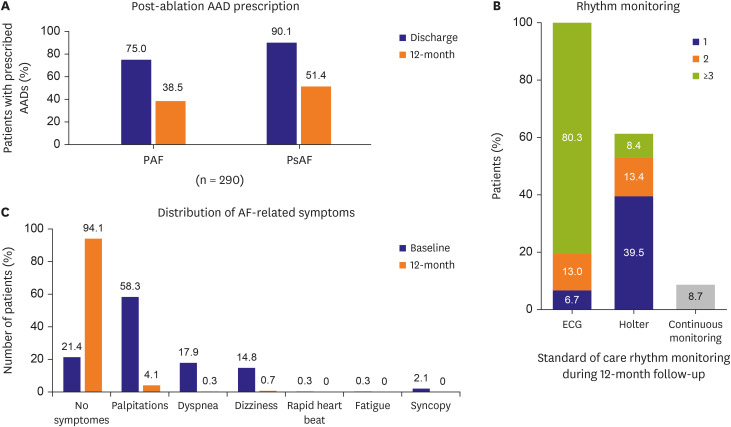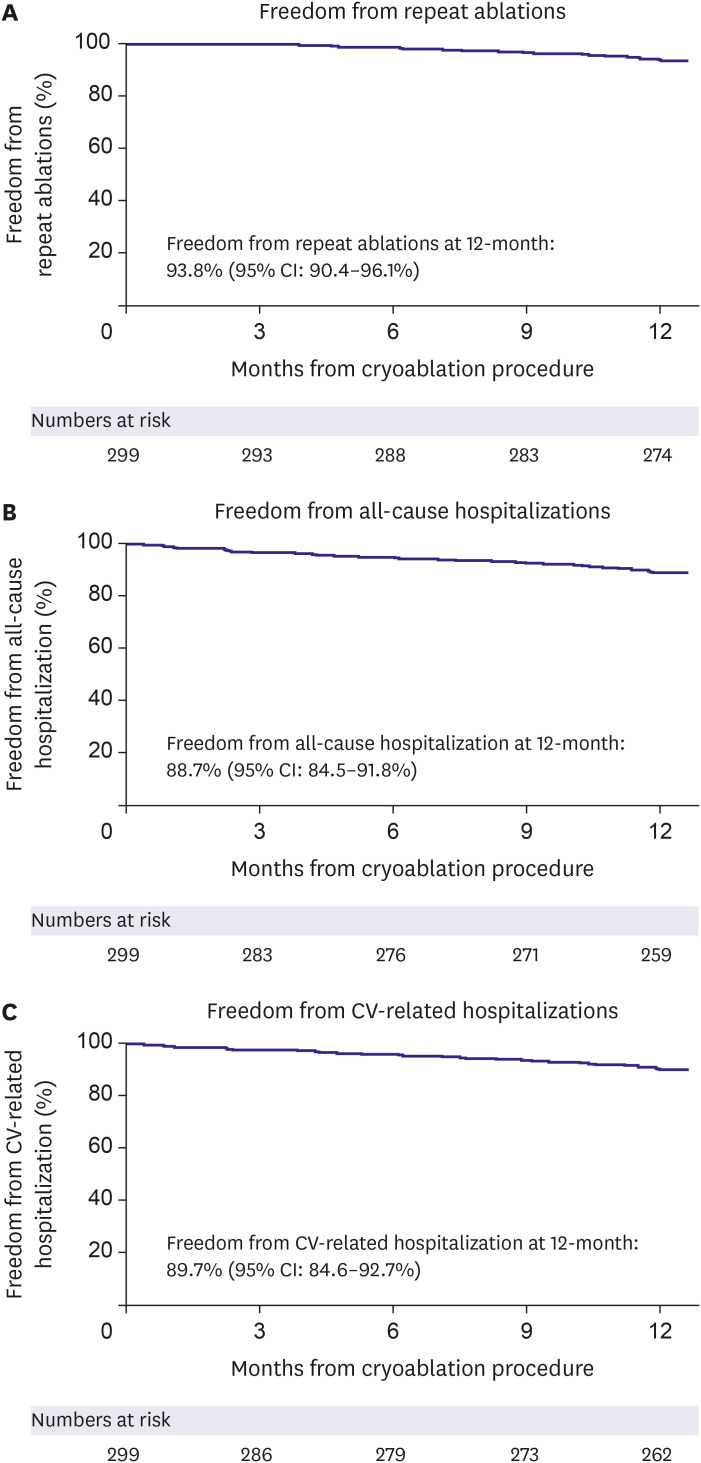Korean Circ J.
2022 Oct;52(10):755-767. 10.4070/kcj.2022.0127.
Cryoballoon Catheter Ablation in Korean Patients With Paroxysmal and Persistent Atrial Fibrillation: One Year Outcome From the Cryo Global Registry
- Affiliations
-
- 1Division of Cardiology, Department of Internal Medicine, Hallym University Sacred Heart Hospital, Anyang, Korea
- 2Department of Internal Medicine, Seoul National University Bundang Hospital, Seoul, Korea
- 3Cardiac Ablation Solutions, Medtronic, Inc., Minneapolis, MN, USA
- 4Division of Cardiology, Department of Medicine, Cardiac Arrhythmia Center, Heart Vascular and Stroke Institute, Samsung Medical Center, Sungkyunkwan University School of Medicine, Seoul, Korea
- KMID: 2534039
- DOI: http://doi.org/10.4070/kcj.2022.0127
Abstract
- Background and Objectives
Cryoballoon catheter ablation for the treatment of patients with symptomatic atrial fibrillation (AF) has been adopted globally, but there are limited multicenter reports of 12-month outcomes in the Korean patient population. This analysis evaluated the clinical performance and safety of cryoballoon ablation (CBA) according to standard-of-care practices in Korea.
Methods
This evaluation of Korean patients with AF was conducted within the larger Cryo Global Registry, which is a prospective, multicenter, post-market registry. Freedom from a ≥30-second recurrence of atrial arrhythmias (after a 90-day blanking period until 12 months) and procedural safety were examined in subjects treated with CBA at 3 Korean centers.
Results
Overall, 299 patients with AF (60±11 years old, 24.7% female, 50.5% paroxysmal AF) underwent CBA using the Arctic Front Advance cryoballoon. Of those, 298 were followed-up for at least 12 months. Mean procedure-, left atrial dwell- and fluoroscopy time was 76±21 minutes, 56±23 minutes, and 27±23 minutes, respectively. Freedom from AF recurrence at 12 months was 83.9% (95% confidence interval [CI], 76.9–88.9%) in the paroxysmal and 61.6% (95% CI, 53.1–69.0%) in the persistent AF cohort. Rhythm monitoring was performed on average 4.7±1.4 times during the follow-up period. Serious device- or procedure-related adverse events occurred in 2 patients (0.7%). The 12-month Kaplan-Meier estimate of freedom from repeat ablation and cardiovascular-related hospitalization was 93.8% (95% CI, 90.4–96.1%) and 89.7% (95% CI, 85.6–92.7%), respectively.
Conclusions
CBA is an efficient, effective, and safe procedure for the treatment of AF patients when used according to real-world practices in Korea. Trial Registration: ClinicalTrials.gov Identifier: NCT02752737
Keyword
Figure
Reference
-
1. Hindricks G, Potpara T, Dagres N, et al. 2020 ESC guidelines for the diagnosis and management of atrial fibrillation developed in collaboration with the European Association for Cardio-Thoracic Surgery (EACTS): the task force for the diagnosis and management of atrial fibrillation of the European Society of Cardiology (ESC) Developed with the special contribution of the European Heart Rhythm Association (EHRA) of the ESC. Eur Heart J. 2021; 42:373–498. PMID: 32860505.2. Calkins H, Hindricks G, Cappato R, et al. 2017 HRS/EHRA/ECAS/APHRS/SOLAECE expert consensus statement on catheter and surgical ablation of atrial fibrillation. Europace. 2018; 20:e1–e160.3. Calkins H, Kuck KH, Cappato R, et al. 2012 HRS/EHRA/ECAS expert consensus statement on catheter and surgical ablation of atrial fibrillation: recommendations for patient selection, procedural techniques, patient management and follow-up, definitions, endpoints, and research trial design. Europace. 2012; 14:528–606. PMID: 22389422.4. Hoffmann E, Straube F, Wegscheider K, et al. Outcomes of cryoballoon or radiofrequency ablation in symptomatic paroxysmal or persistent atrial fibrillation. Europace. 2019; 21:1313–1324. PMID: 31199860.5. Providencia R, Defaye P, Lambiase PD, et al. Results from a multicentre comparison of cryoballoon vs. radiofrequency ablation for paroxysmal atrial fibrillation: is cryoablation more reproducible? Europace. 2017; 19:48–57. PMID: 27267554.6. Velagić V, de Asmundis C, Mugnai G, et al. Learning curve using the second-generation cryoballoon ablation. J Cardiovasc Med (Hagerstown). 2017; 18:518–527. PMID: 28009640.7. Cappato R, Calkins H, Chen SA, et al. Worldwide survey on the methods, efficacy, and safety of catheter ablation for human atrial fibrillation. Circulation. 2005; 111:1100–1105. PMID: 15723973.8. Cappato R, Ali H. Surveys and registries on catheter ablation of atrial fibrillation: fifteen years of history. Circ Arrhythm Electrophysiol. 2021; 14:e008073. PMID: 33441001.9. Chun KR, Okumura K, Scazzuso F, et al. Safety and efficacy of cryoballoon ablation for the treatment of paroxysmal and persistent AF in a real-world global setting: results from the Cryo AF Global Registry. J Arrhythm. 2021; 37:356–367. PMID: 33850577.10. Friedman DJ, Holmes D, Curtis AB, et al. Procedure characteristics and outcomes of atrial fibrillation ablation procedures using cryoballoon versus radiofrequency ablation: a report from the GWTG-AFIB registry. J Cardiovasc Electrophysiol. 2021; 32:248–259. PMID: 33368764.11. Padeletti L, Curnis A, Tondo C, et al. Pulmonary vein isolation with the cryoballoon technique: feasibility, procedural outcomes, and adoption in the real world: data from One Shot Technologies TO Pulmonary Vein Isolation (1STOP) project. Pacing Clin Electrophysiol. 2017; 40:46–56. PMID: 27862043.12. Ferrero-De-Loma-Osorio Á, Cózar R, García-Alberola A, et al. Primary results of the Spanish Cryoballoon Ablation Registry: acute and long-term outcomes of the RECABA study. Sci Rep. 2021; 11:17268. PMID: 34446764.13. Kwon HJ, Choi JH, Kim HR, et al. Radiofrequency vs. cryoballoon vs. thoracoscopic surgical ablation for atrial fibrillation: a single-center experience. Medicina (Kaunas). 2021; 57:1023. PMID: 34684060.14. Pak HN, Park JW, Yang SY, et al. Cryoballoon versus high-power, short-duration radiofrequency ablation for pulmonary vein isolation in patients with paroxysmal atrial fibrillation: a single-center, prospective, randomized study. Circ Arrhythm Electrophysiol. 2021; 14:e010040. PMID: 34465132.15. Balabanski T, Brugada J, Arbelo E, et al. Impact of monitoring on detection of arrhythmia recurrences in the ESC-EHRA EORP atrial fibrillation ablation long-term registry. Europace. 2019; 21:1802–1808. PMID: 31693093.
- Full Text Links
- Actions
-
Cited
- CITED
-
- Close
- Share
- Similar articles
-
- Cryoballoon or Radiofrequency Ablation for Paroxysmal Atrial Fibrillation
- Cryoballoon Ablation for Atrial Fibrillation: a Comprehensive Review and Practice Guide
- Long-term Outcome of Cryoballoon Ablation in Korean Patients With Atrial Fibrillation: Real-World Experience From the Cryo Global Registry
- Is a hybrid procedure the gold standard in patients with persistent atrial fibrillation?
- Catheter Ablation of Long-standing Persistent Atrial Fibrillation: a Reckless Challenge or a Way to Real Cure?




